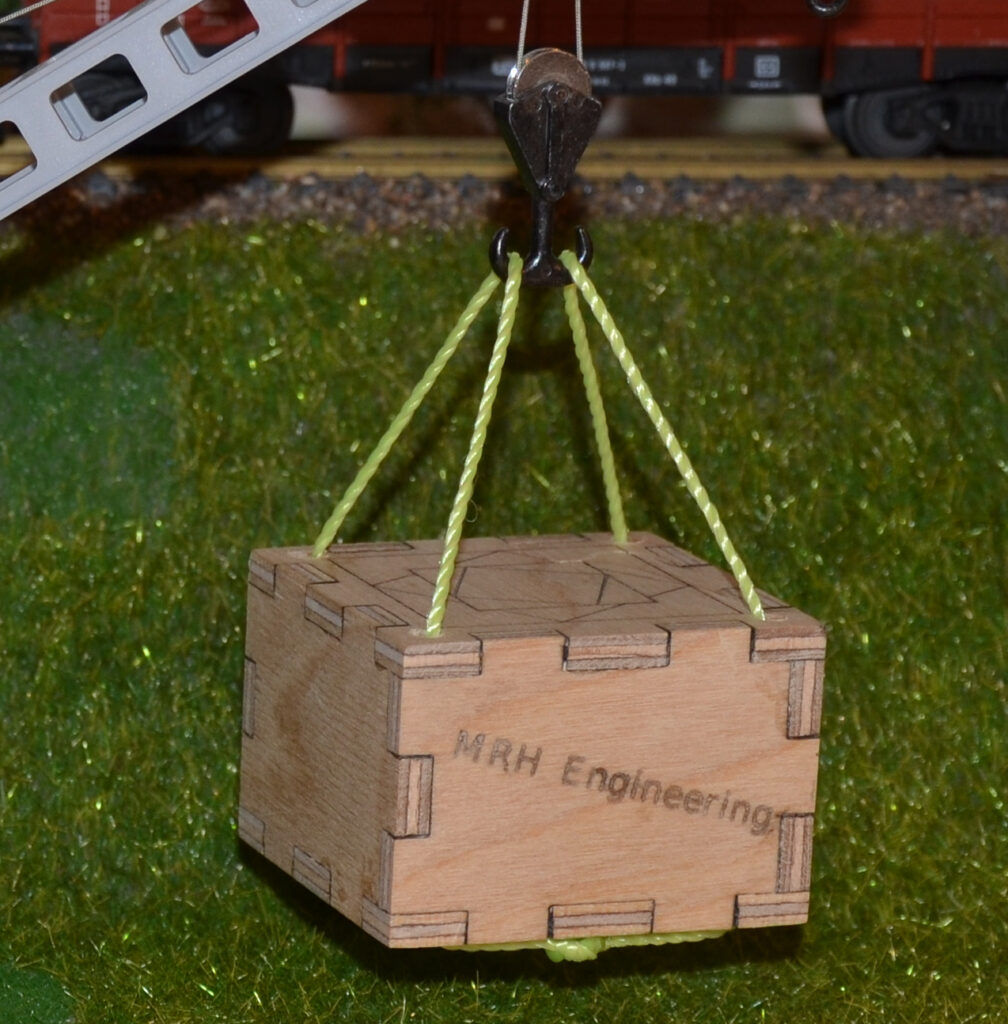
When there are more than three slings attached to one load, then the configuration is statically indeterminate. Therefore, one must consider the stiffness of the slings to compute the load in each of them. I am assuming that the load does not deform. Certifying bodies require this kind of calculation for four-point lifts. The hook load is to be calculated based on the weight of the load and rigging multiplied by all the appropriate safety factors.
I am going to use the energy method for deriving a 1 node FEM model for solving this problem (it is a 5 node model but 4 of them are fixed). The deformation of the slings is measured at the hook point relative to the goods and is denoted by the vector u. The direction of a sling is calculated as described in https://mrhengineering.dk/?p=78 and is denoted n_i. The only difference is that there are 4 points on the goods and as many slings. The stiffness of a sling is k_i measured in the unit force times length per length. Hooks law for one of the slings is:
F_i=\frac{k_i}{L_i}\cdot n_i^T\cdot u
Where L_i = \left|P_i-P_h\right| is the sling length. Note that the vectors are column vectors. The potential energy stored in the sling due to the deformation is
E_i=\frac{1}{2}\frac{k_i}{L_i}\cdot n_i^T\cdot u \cdot n_i^T\cdot u
And the work done by the hook is
W=F_h^T\cdot u
The potential energy must equal the work:
F_h=\sum_{i=1}^n\frac{1}{2}\frac{k_i}{L_i} \cdot n_i \cdot n_i^T \cdot u
This can be rewritten as matrix multiplications to make it easier to implement. First, a matrix is defined N=[n_1…n_i…n_n] and a diagonal matrix with stiffness: k = diag(\frac{k_1}{L_1}…\frac{k_i}{L_i}…\frac{k_n}{L_n}). Then the equations can be rewritten to
F_h=N\cdot k\cdot N^T \cdot u
This way of calculating sling loads can be increased to any number of slings by adding more points. Note that if all slings are in the same plane then the stiffness matrix becomes singular. The same is true if there are less than 3 slings.
Example
It is not that difficult to implement this in some programming language that supports linear algebra. It is also possible to do it with Excel. The coordinates of one hook point and 4 attachment points on the goods is defined:
| A | B | C | D | E | |
| 1 | P_h | P_1 | P_2 | P_3 | P_4 |
| 2 | 0.5 | 0.1 | 0.8 | 0.1 | 0.8 |
| 3 | 0.4 | 0 | 0.1 | 0.7 | 0.7 |
| 4 | 2 | 0 | 0 | 0 | 0 |
| 5 | k_i | 500 | 500 | 500 | 500 |
The same stiffness is assumed for all slings in this example, in which case the sling tension is independent of the value stiffness. However the deformation does change. But if the slings are different (material or cross section) from each other, then it is important to use correct stiffness values.
| A | B | C | D | E | |
| 6 | v_x | -0.4 | 0.3 | -0.4 | 0.3 |
| 7 | v_y | -0.4 | -0.3 | 0.3 | 0.3 |
| 8 | v_z | -2 | -2 | -2 | -2 |
| 9 | Length | 2.08 | 2.04 | 2.06 | 2.04 |
The sling vectors are calculated by entering “=B2:E4-A2:A4” in cell B6 and the lengths are calculated using Pythagoras. The direction vectors N are:
| A | B | C | D | E | |
| 12 | n_x | -0.1925 | 0.1467 | -0.1940 | 0.1467 |
| 13 | n_y | -0.1925 | -0.1467 | 0.1455 | 0.1467 |
| 14 | n_z | -0.9623 | -0.9782 | -0.9701 | -0.9782 |
The direction vectors are computed by entering “=B6#/B9:E9” in cell B12.
| A | B | C | D | E | |||
| 15 | Stiffness | matrix | u | F_h | |||
| 16 | 28.5717 | 2.0617 | 19.9944 | -0.7469 | 0 | ||
| 17 | 2.0617 | 24.5770 | 10.3083 | -0.4024 | 0 | ||
| 18 | 19.9944 | 10.3083 | 919.0656 | 1.1088 | 1000 |
The stiffness matrix is computed by writing “=MMULT(B12#*(B5:E5/B9:E9),TRANSPOSE(B12#))” in cell A16. Note that when you multiply a matrix and a vector using * is the same as converting the vector to a diagonal matrix and use MMULT. Hence, you don’t need to construct the diagonal matrix.
The deformation is calculated based on the hook load, which is an input, by “=MMULT(MINVERSE(A16#),E16:E18)” in cell D16. The deformation is not that interesting to know, it is the tension in the slings we are after – the sling forces is calculated as T_i=-k_i/L_i\cdot n_i\cdot u. This is done by writing “=-TRANSPOSE(MMULT(TRANSPOSE(B12#),D16#))*(B5:E5/B9:E9)” in cell B21.
| A | B | C | D | E | |
| 21 | Tension | 203.5 | 277.6 | 240.0 | 306.5 |
| 22 | F_x | -39.2 | 40.7 | -46.6 | 45.0 |
| 23 | F_y | -39.2 | -40.7 | 34.9 | 45.0 |
| 24 | F_z | -195.8 | -271.6 | -232.8 | -299.8 |
One can check that the sum of sling forces really sums to -F_h by summing the numbers in the table above. The sling force are computed by the line “=B12#*B21#” in B22.

